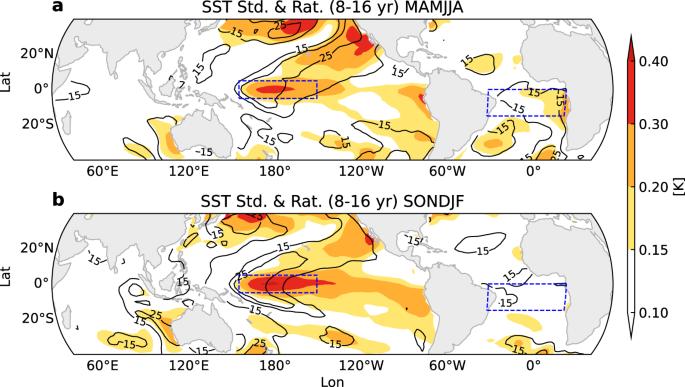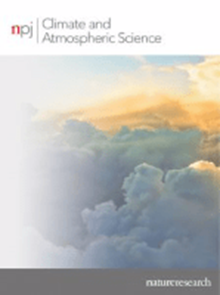Synchronous decadal climate variability in the tropical Central Pacific and tropical South Atlantic
IF 8.4
1区 地球科学
Q1 METEOROLOGY & ATMOSPHERIC SCIENCES
引用次数: 0
Abstract
Pantropical climate interactions across ocean basins operate on a wide range of timescales and can improve the accuracy of climate predictions. Here, we show in observations that Central Pacific (CP) El Niño-like sea surface temperature (SST) anomalies have coevolved with tropical South Atlantic SST anomalies on a quasi-decadal (~10-year) timescale over the past seven decades. During the austral autumn–winter season, decadal warm SSTs in the tropical CP effectively induce tropical SST cooling in the South Atlantic, mainly by strengthening the South Atlantic subtropical anticyclone via an extratropical atmospheric wave teleconnection in the southern hemisphere. Partially coupled pacemaker simulations corroborate the observational findings, indicating that tropical CP decadal SSTs play a primary pacing role, while Atlantic feedback is of secondary importance throughout the study period. Our results suggest that the tropical CP could be an important source of decadal predictability for tropical South Atlantic SST and the surrounding climate.


热带中太平洋和热带南大西洋的十年同步气候变异性
跨大洋盆地的泛热带气候相互作用具有广泛的时间尺度,可以提高气候预测的准确性。在这里,我们通过观测表明,在过去的 70 年中,中太平洋(CP)厄尔尼诺样海面温度(SST)异常与热带南大西洋 SST 异常在准十年(约 10 年)时间尺度上共同演化。在澳大利亚秋冬季节,热带太平洋的十年暖 SST 能有效地引起南大西洋的热带 SST 变冷,主要是通过南半球的外热带大气波远距离联系加强了南大西洋副热带反气旋。部分耦合起搏器模拟证实了观测结果,表明在整个研究期间,热带 CP 十年期 SST 起着主要的起搏作用,而大西洋反馈则是次要的。我们的结果表明,热带 CP 可能是热带南大西洋海温和周围气候十年期可预测性的重要来源。
本文章由计算机程序翻译,如有差异,请以英文原文为准。
求助全文
约1分钟内获得全文
求助全文
来源期刊

npj Climate and Atmospheric Science
Earth and Planetary Sciences-Atmospheric Science
CiteScore
8.80
自引率
3.30%
发文量
87
审稿时长
21 weeks
期刊介绍:
npj Climate and Atmospheric Science is an open-access journal encompassing the relevant physical, chemical, and biological aspects of atmospheric and climate science. The journal places particular emphasis on regional studies that unveil new insights into specific localities, including examinations of local atmospheric composition, such as aerosols.
The range of topics covered by the journal includes climate dynamics, climate variability, weather and climate prediction, climate change, ocean dynamics, weather extremes, air pollution, atmospheric chemistry (including aerosols), the hydrological cycle, and atmosphere–ocean and atmosphere–land interactions. The journal welcomes studies employing a diverse array of methods, including numerical and statistical modeling, the development and application of in situ observational techniques, remote sensing, and the development or evaluation of new reanalyses.
 求助内容:
求助内容: 应助结果提醒方式:
应助结果提醒方式:


